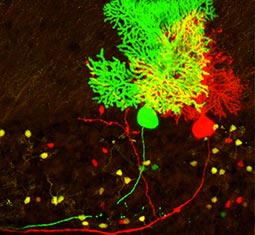October 31, 2014
Wiring the brain
Publication co-authored by Simon Hippenmeyer in Science describes new role of neurotrophins in brain development

A study published in Science (DOI: 10.1126/science.1258996) on October 31 by William Joo and Liqun Luo at Stanford University together with Simon Hippenmeyer, a former postdoc in the Luo lab and now Assistant Professor at IST Austria, describes a new role for neurotrophins during brain development. Neurotrophins are a family of protein signals that are received by receptors. They regulate survival, differentiation and plasticity of neurons. The researchers asked what role neurotrophins play when neurons connect with each other to form functional circuits. They looked specifically at the Neurotrophin-3 (NT-3) signal and its receptor TrkC, which have not been well studied because removing all of NT-3 or TrkC leads to early death before brain development is completed. To circumvent this problem, the authors used the MADM technique to remove the TrkC receptor from only some neurons, and at the same time label these neurons with a color marker to highlight the individual neurons which lost the TrkC receptor.
A class of projection neurons in the cerebellum called Purkinje cells normally have very branched dendrites receiving neuronal input signals. These dendrite “trees” are stunted when the researchers remove TrkC receptors sparsely from just a few single Purkinje cells, which then have dendrites with fewer and shorter branches. In contrast, when they remove TrkC from all Purkinje cells, the dendrite trees look normal again. The authors therefore hypothesize that there is a competitive mechanism at play, in which the shape of the dendrite tree depends on relative differences in TrkC signaling between Purkinje cell neighbors. This would explain why we see defects when Neurotrophin signaling is reduced in some cells, but not when it is reduced in all cells. In further experiments, they show that the NT-3 signal is produced by granule cells, which send inputs to the dendrites of Purkinje cells. When the authors remove the NT-3 signal from all granule cells and at the same time remove the TrkC receptor from single Purkinje cells, the dendrite trees look normal. This is different from the stunted trees seen when only removing the TrkC receptor from individual Purkinje cells.
The results suggest that NT-3 from granule cells is necessary for dendrite shape in Purkinje cells, through a competitive mechanism that depends on the TrkC receptor. Differences in NT-3/TrkC signaling between Purkinje cells affect dendrite shape: cells with lower TrkC levels have stunted dendrite trees, while cells with higher TrkC levels have long, branched dendrites. Joo, Hippenmeyer and Luo thus uncover a new role for neurotrophins in the wiring of the brain. This role is analogous to the classic neurotrophic theory stating that axons compete for neurotrophic factors from target tissues that retrogradely support axon growth. The new findings suggest that growing dendrites require neurotrophic factors from their presynaptic partners for competitive dendrite growth and branching.



